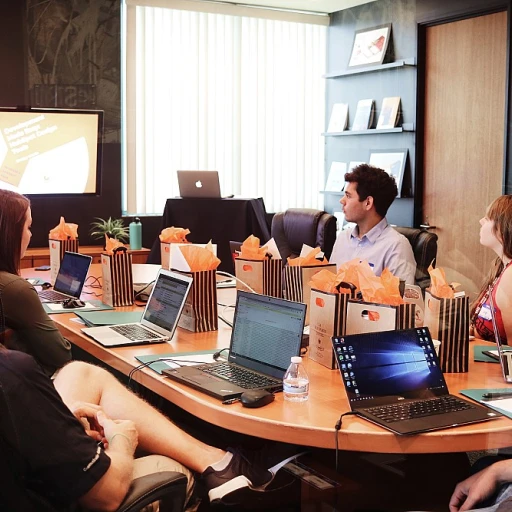
Understanding Workforce Dynamics
Decoding the Workforce Dynamics Puzzle
Understanding the dynamics of the workforce is key to designing effective reskilling programs. As industries evolve, so does the demand for different skills, challenging organizations to stay ahead of these changes. Workforce dynamics encompass various elements including technology, employee behavior, and economic trends, all of which shape an organization’s functioning. The unique interplay of these elements can be seen in systems like UKG Dimensions and Kronos Workforce which offer cloud-based solutions for better workforce management. Organizations often leverage these platforms to comprehend shifts in workforce dimensions, ensuring they remain agile and responsive to changes. Real-time data, when managed effectively, provides insights into training needs and helps identify skills gaps that need addressing. Moreover, systems such as payroll workforce management and workforce timekeeper platforms provide valuable data-driven insights. These systems will help management design targeted training programs by analyzing employee needs, course completions, and pay code adjustments. Instructor-led and downloadable dimensions training modules further enrich this data-driven approach. By better understanding the various aspects of workforce dimensions, organizations can more effectively tailor their reskilling strategies. It becomes critical to embrace a learning-driven approach that takes into account the changing landscape of skills and roles. This lays a solid foundation for future workforce dynamics exploration and strategy formation in reskilling.The Role of Technology in Reskilling
Technological Influences on Workforce Reskilling
In today’s rapidly evolving landscape, the role of technology in shaping workforce reskilling cannot be overstated. As organizations strive to stay competitive, leveraging technology becomes crucial in driving efficient and impactful reskilling initiatives. This exploration addresses how tools and systems, like Kronos and UKG Dimensions, contribute to reshaping workforce strategies.
Technology is a transformative force in reskilling, providing platforms that facilitate seamless training and skill development. Cloud-based solutions such as UKG Pro offer scalable opportunities for training on demand. The Kronos Workforce Dimensions system enables real-time data collection and management, significantly streamlining the learning process. By automating payroll and schedule management, these systems free up valuable time for employees to focus on acquiring new skills.
Data-driven decision-making remains at the core of effective workforce management. By utilizing workforce management solutions, organizations can identify skills gaps and manage training efforts more effectively. Advanced systems also allow for the use of comprehensive workforce dimensions, ensuring that every course and training module addresses specific needs. These tools assist in aligning training objectives with overall strategic goals by providing insights into employee performance and potential areas for development.
Cloud-based management solutions also offer real-time access to training modules, making it easier to distribute resources across different departments. These platforms help implement proactive strategies by deploying timely training based on workforce analytics. Pay codes and other payroll workforce integrations facilitate cost-effective training solutions while optimizing available resources.
Embracing these technological advancements can profoundly improve workforce dynamics. They represent a solution to the multifaceted challenges of reskilling, offering adaptive approaches for companies and employees alike. For more information on adapting to these changes, consider exploring the power of adaptive mindsets.
Identifying Skills Gaps
Spotting the Gaps in Skill Sets
In the evolving landscape of workforce dynamics, pinpointing skill gaps is critical for businesses striving to remain competitive. The ability to accurately identify these gaps involves examining various dimensions, such as workforce management systems, training programs, and real-time performance data.
Utilizing platforms like UKG Dimensions and Kronos Workforce allows organizations to harness data-driven insights. These tools help reveal deficiencies in employee skills that can be addressed through targeted training programs. For instance, a workforce management system can track employee performance over time, comparing it against industry standards and identifying where training is needed most.
Leveraging Modern Systems
The advent of cloud-based systems such as UKG Pro and Kronos Dimensions has revolutionized how organizations manage their workforce. These technologies can schedule courses and track employee progression, enabling managers to implement effective, tailored training interventions.
Management solutions leveraging these systems offer comprehensive data analysis, pinpointing precisely where resources are best allocated. By strategically deploying workforce dimensions, businesses can ensure that their employees are continuously developing skills that align with corporate objectives and current market demands.
Effective Training Initiatives
Once the skills gaps have been identified, organizations can focus on developing comprehensive training initiatives. Instructor-led sessions, online courses, and dimensions training modules should be considered to maximize learning outcomes.
Employers can also download and utilize solutions like workforce timekeeper and payroll workforce to track the impact of these training programs. By doing so, businesses can adjust schedules and pay codes to better support employees in their learning journeys.
A data-driven approach, combining real-time metrics with workforce management systems, will help in tailoring training efforts to meet identified needs effectively. For more insights, consider exploring how accountability training enhances skills.
Strategies for Effective Reskilling
Designing an Effective Learning Pathway
Crafting a successful reskilling strategy involves more than just enrolling employees in courses. It's about creating a comprehensive learning pathway that aligns with both organizational goals and individual career aspirations. Here's how effective reskilling can be achieved:
- Leverage Technology: Implementing advanced systems like cloud-based platforms and data-driven tools can streamline scheduling and management. Solutions such as UKG dimensions or Kronos workforce management help facilitate real-time adjustments and monitor progress efficiently.
- Tailor Training Programs: Customizing training to address specific workforce needs is crucial. This means integrating instructor-led sessions with flexible cloud-based modules to accommodate diverse learning speeds and styles.
- Enhance Workforce Dimensions: Utilize technology to personalize learning experiences. Pro workforce solutions can provide insights into employee performance and identify areas for development, making training both relevant and impactful.
- Utilize Data for Strategic Planning: Analyzing payroll workforce data and pay codes can reveal patterns and trends that inform management decisions. This data-driven approach ensures that resources are allocated efficiently, maximizing the potential of each reskilling initiative.
- Encourage Continuous Learning: Building a culture of perpetual learning is essential. Encourage employees to regularly download updates on the latest industry trends and advancements, keeping skills fresh and adaptable to changing dynamics.
These strategies, when implemented effectively, ultimately augment the capabilities of the workforce, ensuring they remain competitive and agile amidst ever-evolving workforce dynamics.
Challenges in Implementing Reskilling Programs
Overcoming Barriers to Reskilling Initiatives
Implementing reskilling programs within a workforce can be a complex undertaking, with numerous challenges that organizations need to tackle. Workforce dimensions such as time and resource management, as well as data-driven decision-making, play a critical role in overcoming these barriers. Here we explore some of these challenges and how organizations can strategically address them.
One of the foremost challenges is coordinating employee schedules and availability for training sessions, especially in environments that rely on systems like UKG or Kronos. These cloud-based management solutions can provide real-time insights and help allocate training efforts effectively, but they demand precise setup and monitoring.
Another significant challenge lies in the realm of payroll. Workforces must manage pay codes accurately to compensate employees undertaking instructor-led or other forms of training. Systems like Kronos Workforce Timekeeper can simplify such processes by automating the integration with payroll workforce systems.
The advent of technology within workforce management systems opens the door to strategies that can streamline reskilling efforts. However, it also brings the complexity of data management. Organizations must ensure that the use of data is ethical and compliant with regulations, while also being strategically utilized to adapt training programs to changing needs.
To effectively scale reskilling initiatives, companies can leverage cloud-based solutions such as UKG Dimensions or Pro Workforce. These tools offer real-time analytics, providing insights into employee progress and the effectiveness of training modules.
Finally, it is imperative for organizations to foster a learning culture. By encouraging continuous development and embracing a proactive approach towards skill enhancement, businesses can reduce resistance to new learning management systems and initiatives. Equipping teams with the right tools and mindset will undoubtedly prove beneficial in navigating the complexities of workforce dynamics.













